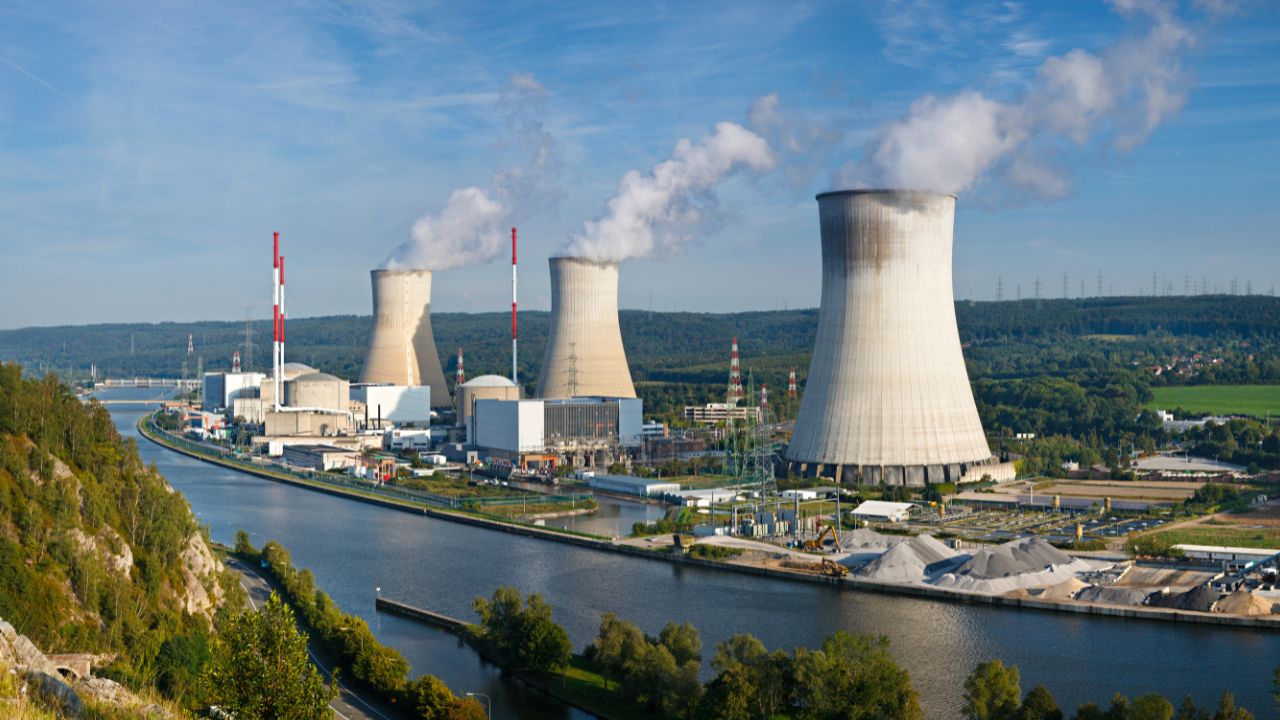
Exploring Canada's Multi-Billion Dollar Nuclear Upgrades
10 Sept, 202413:03The nuclear industry is making a global comeback, driven by the urgent need to address clima...

The nuclear industry is making a global comeback, driven by the urgent need to address climate change and the growing demand for renewable energy sources. As the world grapples with these two challenges, nuclear energy offers a compelling solution.
According to the World Nuclear Association, nuclear power provides about 9% of the world’s electricity and is recognised as the second-largest source of low-carbon energy. The industry's expansion is prominent, with approximately 440 nuclear reactors operating across 32 countries and about 60 new reactors under construction.
This global momentum is also mirrored in Canada, where sizeable investments are being made to upgrade and expand nuclear plants. Canada currently generates about 15% of its electricity from nuclear power, with 19 reactors primarily located in Ontario, providing 13.6 gigawatts of power capacity. The focus on nuclear energy is part of a broader effort to maintain a diverse and sustainable energy mix, which includes contributions from hydroelectric and renewable sources. The Canadian government and private sector are investing heavily in large-scale nuclear projects and the development of small modular reactors (SMRs), which are seen as promising initiatives for the future.
Canada’s nuclear industry is deeply rooted in innovation. The country has been a leader in nuclear research and technology for many years. One of their pioneering developments is the CANDU (Canadian Deuterium-Uranium) reactor system, on which all plants in Canada operate. This unique technology uses pressurised fuel channels with natural uranium and heavy water, allowing for continuous refuelling at full power - distinguishing CANDU from other reactor designs. In addition to energy production, Canada also uses nuclear power to contribute to medical and industrial applications. This multifaceted approach underscores Canada's nuclear sector's economic and societal benefits, which support over 30,000 direct jobs and generate substantial revenues annually.

Overview of Government Nuclear Intentions - Ontario's Largest Battery Storage Procurement
Canada’s commitment to nuclear energy is exemplified by several high-profile projects to refurbish existing facilities and CANDU plants to extend their operating time. This effort is encapsulated in the Powering Ontario’s Growth plan, which aims to improve the province’s clean energy capabilities and ensure reliability for the future. A vital component of this initiative is the recent completion of the largest battery storage procurement in Canadian history. This procurement secured 2,195 megawatts (MW) capacity, with 1,784MW dedicated to clean energy storage across ten projects. These projects, ranging from 9 to 390MW, will collectively form a storage fleet with a total capacity of 2,916MW, surpassing the initial target of 2,500MW.
The Ontario government's plans extend beyond storage to include significant nuclear energy and transmission infrastructure advancements. Pre-development work for new nuclear upgrades at Bruce and Darlington, alongside refurbishing existing facilities like the Pickering Nuclear Generation Station, underscores Ontario's commitment to reliable and clean nuclear power. Additionally, the government is prioritising new transmission lines to support key industries, such as electric vehicle and battery manufacturing and clean steel production. These efforts are complemented by a $342 million expansion of energy efficiency programs and competitive procurements for non-emitting electricity resources, including wind, solar, and bioenergy.
In a decarbonisation report by the Independent Electricity Systems Operator (IESO), Ontario’s electricity demand is expected to double by 2025, potentially increasing from 150 TWh to 300 TWh. With forecasts like this, Canada is acting fast to ensure they have the energy to power economic growth and sustainability over time.

The Top Multi-Billion Upgrades
1. Bruce Power
Located on the eastern shore of Lake Huron in Tiverton, Bruce Power is Canada’s largest nuclear power plant, with a capacity of 6.2 GW. The refurbishment initiative, part of a long-term agreement with the Ontario government, involves overhauling all eight reactor units to provide clean, reliable energy until at least 2064, ensuring the facility meets 7% of Ontario's energy requirements.
The refurbishment began with the Life-Extension Program in 2016, focusing on replacing older systems during scheduled maintenance outages. A significant component of this initiative is the Major Component Replacement (MCR) project, which began in January 2020. This entails replacing critical reactor components such as steam generators, pressure tubes, calandria tubes, and feeder tubes in Units 3 to 8.
The most recent refurbishment of Unit 6 was completed in September 2023, with a contract value of $3.4 billion. The contract was awarded to Shoreline Power Group - a joint venture between Aecon, AECOM, AtkinsRéalis, SNC-Lavalin, and United Engineering - for Fuel Channel and Feeder Replacement (FCFR). This unit is now synchronised to Ontario’s electricity at 30% power, capable of powering over 900,000 homes annually and significantly contributing to Ontario’s clean energy supply. Unit 6 is projected to prevent more than 90.5 million tCO₂e emissions from Ontario's electricity grid throughout its operational lifetime. Following the refurbishment of Unit 6, work continues on MCR3 and will subsequently proceed with Units 4,5,7 and 8. Shoreline has also been awarded another $1.3 billion contract for FCFR on the remaining units.
The MCR project not only extends the life of the reactors by 30 to 35 years but also secures approximately 22,000 jobs directly and indirectly, with an additional 5,000 jobs annually throughout the investment program. This economic boost is complemented by establishing new supplier facilities in Bruce, Grey, and Huron counties, transforming the region into a hub for nuclear energy innovation.
2. Darlington Nuclear Station
Located in Bowmanville, the Darlington Nuclear Station, operated by Ontario Power Generation (OPG), is one of the world’s top-performing nuclear plants, producing 20% of Ontario’s electricity since the 1990s. The ongoing refurbishment project, valued at $12.8 billion, aims to extend the life of its four CANDU-850 reactors by 30 years, ensuring a stable supply of clean energy for Ontario until 2055. The project began in 2016 and involved meticulous planning and execution to replace critical reactor components.
The Darlington station features four Pressurised Heavy Water Reactors (PHWR), each with a net capacity of 878 MWe. The refurbishment includes replacing all 480 pressure tubes and 960 feeder tubes in each reactor and other components. The project is being executed by a joint venture between Aecon and AtkinsRéalis, leveraging tools and methods developed during the project’s definition phase.
The timeline and progress of the refurbishment are as follows:
- Unit 2: Refurbishment began in October 2016 and was completed in June 2020.
- Unit 3: Work started in September 2020 and was completed ahead of schedule in July 2023, providing an additional 3 TWh of electricity.
- Unit 1: Refurbishment began in February 2022 and is expected to be completed by Q4 2024.
- Unit 4: The final unit’s refurbishment started in July 2023, with expected completion by Q4 2026.
The project is expected to significantly reduce greenhouse gas emissions, with an estimated 297 megatonnes of CO2 reduction from 2024 to 2055. This is equivalent to removing 2 million cars from the road. The refurbishment and the additional 30 years of operation are also expected to provide substantial employment opportunities, creating 14,200 jobs annually.
3. Small Modular Reactors (SMRs) at Darlington
In addition to refurbishing existing reactors, OPG is investing in developing small modular reactors (SMRs) at Darlington. With a $970 million loan for phase 1 from the Canada Infrastructure Bank, this project represents Canada's first foray into SMR technology. SMRs are touted as transformative for the nuclear industry, offering a more flexible and scalable solution for power generation.
OPG initiated its expansion of Darlington in 2020, planning to build an SMR at the site that would start operating by 2028. The project advanced with the first groundbreaking in December 2022, and a contract was signed in January 2023 to deploy the first GE Vernova BWRX-300 SMR. Once installed, the SMR will reduce CO2 emissions by an average of 740 kilotonnes annually between 2029 and 2050.
In July 2023, the Ontario government announced plans to work with OPG to begin planning and licensing three additional BWRX-300 SMRs, bringing the total to four at the Darlington site. Pending Canadian Nuclear Safety Commission (CNSC) regulatory approvals, these additional units could bring the total output to 1,200 megawatts, sufficient to power approximately 1.2 million homes.
The Darlington SMR project is expected to have a substantial economic impact, potentially sustaining 2,000 jobs annually over the fleet's 60-year lifetime and contributing $13.7 billion to Ontario’s GDP through construction and operation. This initiative addresses growing electricity demands and aligns with net-zero goals, reinforcing Ontario's position as a leader in clean energy technology.
4. Pickering
The refurbishment of Pickering Nuclear is a major project aimed at extending the life of Canada’s oldest nuclear power plant by at least 30 years. With an estimated cost of $13 billion, this initiative is expected to create approximately 11,000 jobs annually and boost Ontario’s GDP by $19.4 billion over the refurbishment period.
The Ontario government has announced its support with a $2 billion budget for OPG’s plan to refurbish Pickering’s Units 5 to 8, which are CANDU reactors initially constructed in the early 1980s. These units, collectively known as Pickering B, will undergo a significant overhaul to replace critical components such as pressure tubes, calandria tubes, and feeder pipes. Once completed, these units will supply 2,100 megawatts of power, enough to meet the needs of two million homes.
The project is in the initiation phase, with engineering, design, and procurement activities underway. This phase will last through the end of 2024, during which OPG will secure long-lead components and prepare for the refurbishment work when Units 5 to 6 are shut down in 2026. The refurbishment will help Ontario attract global business investments by providing reliable, affordable, clean electricity.
Challenges and Opportunities in Nuclear Recruitment
The ambitious nuclear projects in Canada present many opportunities for nuclear industry professionals. However, they also pose several recruitment challenges that must be addressed to ensure their successful execution.
- Limited Local Talent Pool: One of the primary challenges facing the nuclear sector in Canada is the limited local talent pool. The specialised skills required for nuclear projects are not widely available, necessitating the recruitment of professionals from abroad. Visa constraints and lengthy processing times further complicate this situation, delaying project timelines.
- New Technology and Sectors: Introducing new technologies like SMRs requires technical expertise. This creates a demand for nuclear consultants and engineers with experience in these emerging technologies. Companies like NES Fircroft help bridge this gap by providing tailored nuclear recruitment solutions and connecting clients with the right talent.
- Simultaneous Projects: The concurrent execution of multiple major nuclear projects in Canada exacerbates the recruitment challenge. With several projects requiring similar skill sets, the competition for qualified professionals is intense. This situation highlights the importance of strategic recruitment solutions that can efficiently source and deploy talent across projects.
- Financial and Logistical Constraints: The substantial financial investments and long lead times associated with nuclear projects add another layer of complexity to recruitment efforts. Ensuring the right personnel are in place at the right time is critical to maintaining project schedules and budgets.

NES Fircroft – Providing Leading Workforce Solutions
NES Fircroft has been operating in Canada for over 20 years, with offices in Ontario, Calgary, and Bonnyville, providing workforce solutions to various clients nationwide. We offer access to a global network of skilled professionals, giving you the support and expertise to drive business success. By using our consultants' knowledge, companies can successfully navigate the complexities of nuclear recruitment and contribute to Canada's clean energy goals in an efficient and compliant manner.
Explore our range of talent acquisition services or contact us today.








